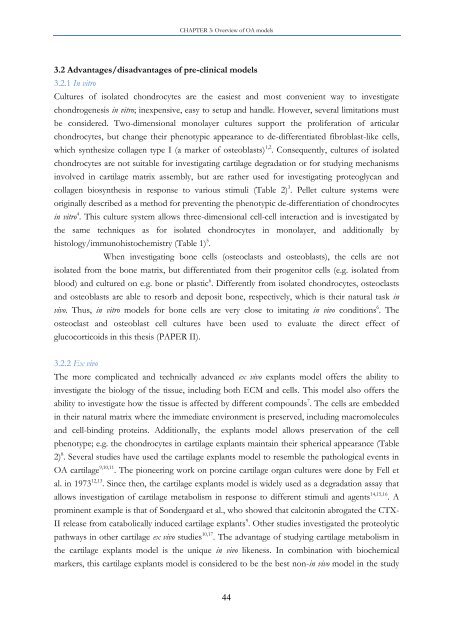Identification of important interactions between subchondral bone ...
Identification of important interactions between subchondral bone ...
Identification of important interactions between subchondral bone ...
Create successful ePaper yourself
Turn your PDF publications into a flip-book with our unique Google optimized e-Paper software.
CHAPTER 3: Overview <strong>of</strong> OA models<br />
3.2 Advantages/disadvantages <strong>of</strong> pre-clinical models<br />
3.2.1 In vitro<br />
Cultures <strong>of</strong> isolated chondrocytes are the easiest and most convenient way to investigate<br />
chondrogenesis in vitro; inexpensive, easy to setup and handle. However, several limitations must<br />
be considered. Two-dimensional monolayer cultures support the proliferation <strong>of</strong> articular<br />
chondrocytes, but change their phenotypic appearance to de-differentiated fibroblast-like cells,<br />
which synthesize collagen type I (a marker <strong>of</strong> osteoblasts) 1,2 . Consequently, cultures <strong>of</strong> isolated<br />
chondrocytes are not suitable for investigating cartilage degradation or for studying mechanisms<br />
involved in cartilage matrix assembly, but are rather used for investigating proteoglycan and<br />
collagen biosynthesis in response to various stimuli (Table 2) 3 . Pellet culture systems were<br />
originally described as a method for preventing the phenotypic de-differentiation <strong>of</strong> chondrocytes<br />
in vitro 4 . This culture system allows three-dimensional cell-cell interaction and is investigated by<br />
the same techniques as for isolated chondrocytes in monolayer, and additionally by<br />
histology/immunohistochemistry (Table 1) 5 .<br />
When investigating <strong>bone</strong> cells (osteoclasts and osteoblasts), the cells are not<br />
isolated from the <strong>bone</strong> matrix, but differentiated from their progenitor cells (e.g. isolated from<br />
blood) and cultured on e.g. <strong>bone</strong> or plastic 6 . Differently from isolated chondrocytes, osteoclasts<br />
and osteoblasts are able to resorb and deposit <strong>bone</strong>, respectively, which is their natural task in<br />
vivo. Thus, in vitro models for <strong>bone</strong> cells are very close to imitating in vivo conditions 6 . The<br />
osteoclast and osteoblast cell cultures have been used to evaluate the direct effect <strong>of</strong><br />
glucocorticoids in this thesis (PAPER II).<br />
3.2.2 Ex vivo<br />
The more complicated and technically advanced ex vivo explants model <strong>of</strong>fers the ability to<br />
investigate the biology <strong>of</strong> the tissue, including both ECM and cells. This model also <strong>of</strong>fers the<br />
ability to investigate how the tissue is affected by different compounds 7 . The cells are embedded<br />
in their natural matrix where the immediate environment is preserved, including macromolecules<br />
and cell-binding proteins. Additionally, the explants model allows preservation <strong>of</strong> the cell<br />
phenotype; e.g. the chondrocytes in cartilage explants maintain their spherical appearance (Table<br />
2) 8 . Several studies have used the cartilage explants model to resemble the pathological events in<br />
OA cartilage 9,10,11 . The pioneering work on porcine cartilage organ cultures were done by Fell et<br />
al. in 1973 12,13 . Since then, the cartilage explants model is widely used as a degradation assay that<br />
allows investigation <strong>of</strong> cartilage metabolism in response to different stimuli and agents 14,15,16 . A<br />
prominent example is that <strong>of</strong> Sondergaard et al., who showed that calcitonin abrogated the CTX-<br />
II release from catabolically induced cartilage explants 9 . Other studies investigated the proteolytic<br />
pathways in other cartilage ex vivo studies 10,17 . The advantage <strong>of</strong> studying cartilage metabolism in<br />
the cartilage explants model is the unique in vivo likeness. In combination with biochemical<br />
markers, this cartilage explants model is considered to be the best non-in vivo model in the study<br />
44

















